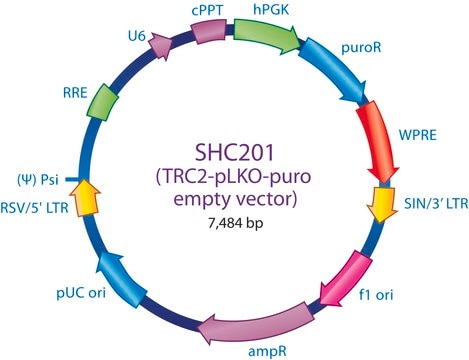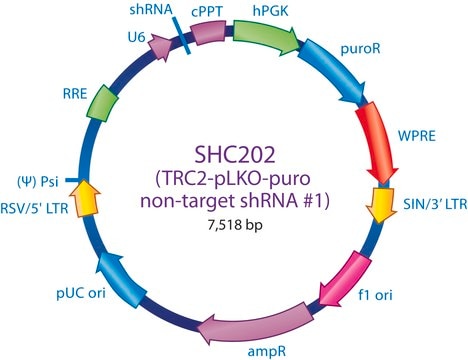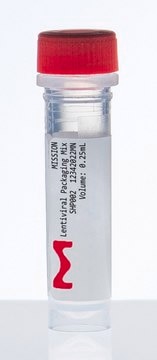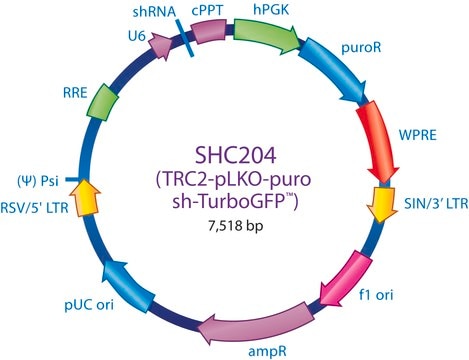SHC202
MISSION® TRC2 pLKO.5-puro Non-Mammalian shRNA Control Plasmid DNA
Targets no known mammalian genes
Synonym(s):
MISSION® Control Vectors
Sign Into View Organizational & Contract Pricing
All Photos(1)
About This Item
Recommended Products
Quality Level
product line
MISSION®
concentration
500 ng/μL in TE buffer; DNA (10μg of plasmid DNA)
shipped in
dry ice
storage temp.
−20°C
Looking for similar products? Visit Product Comparison Guide
Related Categories
General description
This shRNA non-mammalian control was designed using our Turbo GFP sequence and may cause some knockdown of tGFP. For maximum knockdown of tGFP, please refer to SHC004, SHC004V, SHC004H, SHC204, or SHC204V.
The MISSION® TRC2 Control Vector pLKO-puro Non-Target shRNA is a lentivirus plasmid vector. This vector is in the TRC2 pLKO-puro plasmid backbone, which contains the WPRE.
Ampicillin and puromycin antibiotic resistance genes provide selection in bacterial or mammalian cells respectively. In addition, self-inactivating replication incompetent viral particles can be produced in packaging cells (HEK293T) by co-transfection with compatible packaging plasmids (SHP001). The TRC2 Non-Target shRNA Control Vector is provided as 10 μg of plasmid DNA in Tris-EDTA (TE) buffer at a concentration of 500 ng/μl.
The MISSION® TRC2 Control Vector pLKO-puro Non-Target shRNA is a lentivirus plasmid vector. This vector is in the TRC2 pLKO-puro plasmid backbone, which contains the WPRE.
Ampicillin and puromycin antibiotic resistance genes provide selection in bacterial or mammalian cells respectively. In addition, self-inactivating replication incompetent viral particles can be produced in packaging cells (HEK293T) by co-transfection with compatible packaging plasmids (SHP001). The TRC2 Non-Target shRNA Control Vector is provided as 10 μg of plasmid DNA in Tris-EDTA (TE) buffer at a concentration of 500 ng/μl.
Application
Small interfering RNAs (siRNAs) expressed from short hairpin RNAs (shRNAs) are a powerful way to mediate gene specific RNA interference (RNAi) in mammalian cells. The MISSION® product line is based on a viral vector-based RNAi library against annotated mouse and human genes. shRNAs that generate siRNAs intracellularly are expressed from amphotropic lentivirus viral particles, allowing screening in a wide range of mammalian cell lines. In these cell lines, MISSION® shRNA clones permit rapid, cost efficient loss-of-function and genetic interaction screens. The vector contains an shRNA insert that does not target human or mouse genes, making it useful as a negative control in experiments using the MISSION® TRC2 shRNA library clones. This allows one to examine the effect of transfection of a short-hairpin on gene expression and interpret the knockdown effect seen with shRNA clones.
To see more application data, protocols, vector maps visit sigma.com/shrna.
Legal Information
Use of this product is subject to one or more license agreements. For details, please see http://sigmaaldrich.com/missionlicense.
MISSION is a registered trademark of Merck KGaA, Darmstadt, Germany
recommended
Product No.
Description
Pricing
Storage Class
12 - Non Combustible Liquids
wgk_germany
WGK 1
Certificates of Analysis (COA)
Search for Certificates of Analysis (COA) by entering the products Lot/Batch Number. Lot and Batch Numbers can be found on a product’s label following the words ‘Lot’ or ‘Batch’.
Already Own This Product?
Find documentation for the products that you have recently purchased in the Document Library.
Customers Also Viewed
Adaptor protein-3: A key player in RBL-2H3 mast cell mediator release.
da Silva EZ
PLoS ONE, 12(3), e0173462-e0173462 (2017)
Tianhe Huang et al.
Nature communications, 11(1), 2124-2124 (2020-05-03)
Penile squamous cell carcinoma (PSCC) accounts for over 95% of penile malignancies and causes significant mortality and morbidity in developing countries. Molecular mechanisms and therapies of PSCC are understudied, owing to scarcity of laboratory models. Herein, we describe a genetically
Lou-Ella M M Alexander et al.
Molecular immunology, 91, 8-16 (2017-09-01)
B cell activation is dependent on a large increase in transcriptional output followed by focused expression on secreted immunoglobulin as the cell transitions to an antibody producing plasma cell. The rapid transcriptional induction is facilitated by the release of poised
Succination is Increased on Select Proteins in the Brainstem of the NADH dehydrogenase (ubiquinone) Fe-S protein 4 (Ndufs4) Knockout Mouse, a Model of Leigh Syndrome.
Piroli CG
Molecular and Cellular Proteomics, 15(2), 445-461 (2016)
Ruben G de Bruin et al.
Nature communications, 7, 10846-10846 (2016-04-01)
A hallmark of inflammatory diseases is the excessive recruitment and influx of monocytes to sites of tissue damage and their ensuing differentiation into macrophages. Numerous stimuli are known to induce transcriptional changes associated with macrophage phenotype, but posttranscriptional control of
Our team of scientists has experience in all areas of research including Life Science, Material Science, Chemical Synthesis, Chromatography, Analytical and many others.
Contact Technical Service







